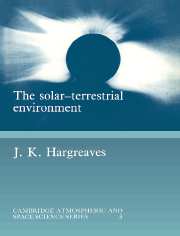 The Solar-Terrestrial Environment
The Solar-Terrestrial Environment Book contents
- Frontmatter
- Contents
- Preface
- 1 The Earth in space
- 2 The physics of geospace
- 3 Techniques for observing geospace
- 4 The neutral atmosphere
- 5 The solar wind and the magnetosphere
- 6 Principles of the ionosphere at middle and low latitudes
- 7 Ionospheric phenomena at middle and low latitudes
- 8 The ionosphere at high latitude
- 9 Magnetospheric waves
- 10 Technological application of geospace science
- Index
4 - The neutral atmosphere
Published online by Cambridge University Press: 29 January 2010
- Frontmatter
- Contents
- Preface
- 1 The Earth in space
- 2 The physics of geospace
- 3 Techniques for observing geospace
- 4 The neutral atmosphere
- 5 The solar wind and the magnetosphere
- 6 Principles of the ionosphere at middle and low latitudes
- 7 Ionospheric phenomena at middle and low latitudes
- 8 The ionosphere at high latitude
- 9 Magnetospheric waves
- 10 Technological application of geospace science
- Index
Summary
…this most excellent canopy, the air, look you, this brave o'erhanging firmament, this majestical roof fretted with golden fire, why, it appears no other thing to me than a foul and pestilent congregation of vapours.
W. Shakespeare, Hamlet, Act II Scene (ii)Vertical structure
Nomenclature of atmospheric vertical structure
The static atmosphere is described by the four properties, pressure (P), density (ρ), temperature (T) and composition. Between them these properties determine much of the atmosphere's behaviour. They are not independent, being related by the universal gas law which may be written in various forms (Equations 2.5–2.7). For our purposes the form
P = nkT, (Equation 2.7)
where n is the number of molecules per unit volume, is particularly useful. The quantity ‘n’ is properly called the concentration or the number density, but density alone is often used when the sense is clear.
The regions of the neutral atmosphere are named according to various schemes based in particular on the variations with height of the temperature, the composition, and the state of mixing. Figure 4.1 illustrates the most commonly used terms. The primary classification is according to the temperature gradient. In this system the regions are ‘spheres’ and the boundaries are ‘pauses’. Thus the troposphere, in which the temperature falls off at 10 K/km or less, is bounded by the tropopause at a height of 10–12 km. The stratosphere above was originally thought to be isothermal, but in fact is a region where the temperature increases with height. A maximum, due to heating by ultra-violet absorption in ozone, appears at about 50 km and this is the stratopause.
- Type
- Chapter
- Information
- The Solar-Terrestrial EnvironmentAn Introduction to Geospace - the Science of the Terrestrial Upper Atmosphere, Ionosphere, and Magnetosphere, pp. 98 - 131Publisher: Cambridge University PressPrint publication year: 1992


